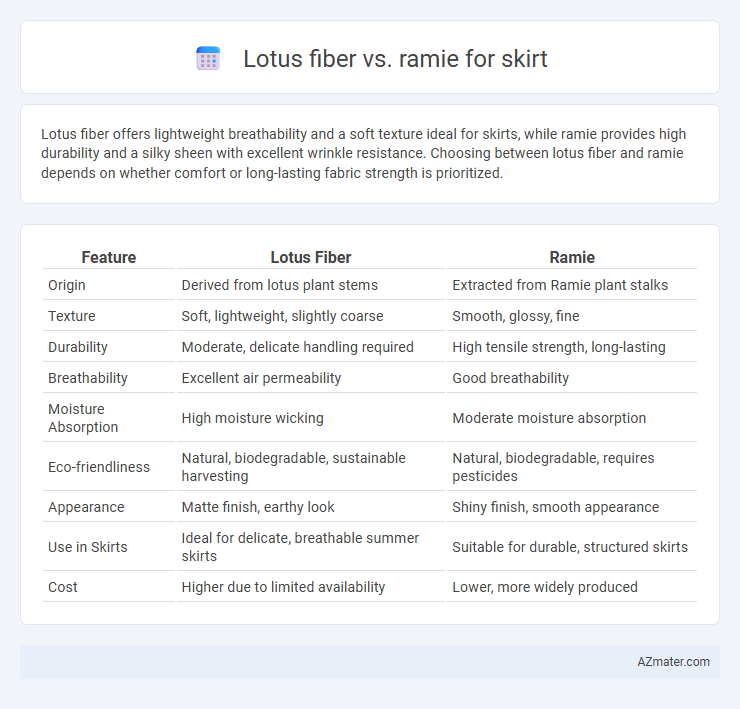Lotus fiber offers lightweight breathability and a soft texture ideal for skirts, while ramie provides high durability and a silky sheen with excellent wrinkle resistance. Choosing between lotus fiber and ramie depends on whether comfort or long-lasting fabric strength is prioritized.
Table of Comparison
| Feature | Lotus Fiber | Ramie |
|---|---|---|
| Origin | Derived from lotus plant stems | Extracted from Ramie plant stalks |
| Texture | Soft, lightweight, slightly coarse | Smooth, glossy, fine |
| Durability | Moderate, delicate handling required | High tensile strength, long-lasting |
| Breathability | Excellent air permeability | Good breathability |
| Moisture Absorption | High moisture wicking | Moderate moisture absorption |
| Eco-friendliness | Natural, biodegradable, sustainable harvesting | Natural, biodegradable, requires pesticides |
| Appearance | Matte finish, earthy look | Shiny finish, smooth appearance |
| Use in Skirts | Ideal for delicate, breathable summer skirts | Suitable for durable, structured skirts |
| Cost | Higher due to limited availability | Lower, more widely produced |
Introduction to Natural Fibers in Fashion
Lotus fiber and ramie are natural fibers increasingly valued in sustainable fashion for their eco-friendly properties and unique textures. Lotus fiber, harvested from lotus stems, offers exceptional breathability and softness, making it ideal for lightweight skirts with a luxurious feel. Ramie, derived from the stalks of the Chinese nettle plant, provides high durability and resistance to wrinkle, lending skirts a structured yet comfortable wear suitable for everyday and formal occasions.
What is Lotus Fiber?
Lotus fiber, derived from the stalks of the lotus plant, is a rare and eco-friendly textile known for its lightweight, breathable, and silky texture, making it ideal for skirts in hot climates. Unlike ramie, which is a bast fiber extracted from the stalks of the ramie plant and prized for its strength and durability, lotus fiber offers a more luxurious and natural luster with hypoallergenic properties. Both fibers are sustainable alternatives to synthetic materials, but lotus fiber's unique extraction process and limited availability contribute to its higher value and exclusivity in fashion.
What is Ramie Fiber?
Ramie fiber is a natural vegetable fiber derived from the stalks of the Ramie plant (Boehmeria nivea), known for its strength, luster, and resistance to mildew. It produces a lightweight, breathable fabric often blended with cotton or linen, making it an excellent choice for skirts that require durability and a smooth finish. Compared to Lotus fiber, Ramie offers higher tensile strength and better moisture absorption, enhancing comfort and longevity in apparel.
Production Process: Lotus vs. Ramie
Lotus fiber production involves harvesting lotus stalks, extracting the inner fibers through soaking and manual separation, resulting in a soft, lightweight material ideal for luxury skirts. Ramie fiber is derived from the stems of the Ramie plant, where the stalks undergo a degumming process to remove the gummy substances, producing a strong, lustrous fiber often blended for durability. The labor-intensive and eco-friendly lotus fiber extraction contrasts with Ramie's chemical-assisted processing, influencing the texture and sustainability profile of skirts made from each fiber.
Texture and Feel: Comfort Comparison
Lotus fiber offers a soft, smooth texture with a natural sheen, providing a breathable and lightweight feel ideal for comfortable skirts. Ramie, while durable and slightly stiffer, has a coarse texture but softens with washing, making skirts more structured yet breathable. Both fibers excel in moisture-wicking, but lotus fiber tends to deliver superior comfort due to its silk-like softness and hypoallergenic properties.
Durability and Longevity
Lotus fiber offers exceptional durability due to its long, fine filaments that resist wear and tear, making it ideal for skirts intended for frequent use. Ramie boasts high tensile strength and excellent resistance to mildew and stretching, resulting in skirts that maintain shape and longevity in various conditions. Both fibers provide long-lasting performance, but lotus fiber's unique natural toughness often surpasses ramie in lifespan and wear resistance.
Eco-Friendliness and Sustainability
Lotus fiber and ramie both offer eco-friendly and sustainable options for skirts, with lotus fiber being highly biodegradable and requiring minimal water and pesticides during cultivation. Ramie, a bast fiber, features rapid growth and high yield per acre, reducing land use and environmental impact while providing durability and breathability. Choosing either fiber supports sustainable fashion by promoting natural, renewable plant materials with lower carbon footprints compared to synthetic alternatives.
Dyeing and Color Retention
Lotus fiber exhibits excellent dye absorption and vibrant color retention due to its natural cellulose structure, making it ideal for skirts requiring long-lasting hues. Ramie fabric, known for its smooth texture and high luster, also holds dye well but may fade faster under repeated washing compared to lotus fiber. Both fibers support eco-friendly dyeing processes, but lotus fiber tends to maintain color intensity longer, enhancing skirt durability and aesthetic appeal.
Cost and Accessibility
Lotus fiber, derived from lotus plant stems, is rare and costly due to its labor-intensive extraction process, making skirts made from it generally more expensive and less accessible. Ramie fiber, sourced from the nettle family plant, is more abundant and affordable, offering a cost-effective alternative with wider availability for skirt production. Consumers seeking unique, eco-friendly fabrics may face higher prices with lotus fiber skirts, while ramie provides a budget-friendly option with similar durability and breathability.
Which Fiber Wins for Skirt Fabric?
Lotus fiber offers exceptional breathability, natural sheen, and remarkable softness, making it ideal for lightweight, luxurious skirts. Ramie, known for its durability and moisture-wicking properties, provides a stiffer texture that holds pleats well but lacks the fluid drape of lotus fiber. For skirt fabric, lotus fiber wins with superior comfort and elegance, while ramie suits structured, long-lasting skirts where resilience is prioritized.

Infographic: Lotus fiber vs Ramie for Skirt
 azmater.com
azmater.com